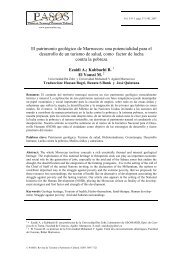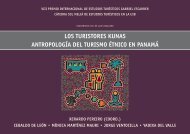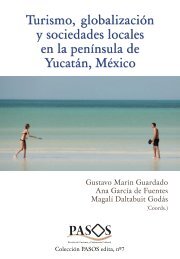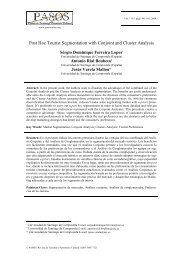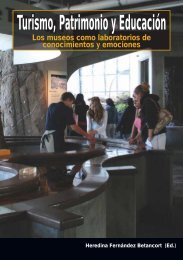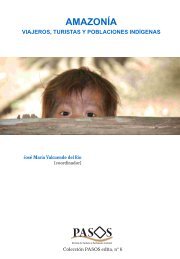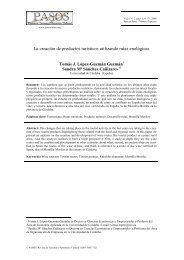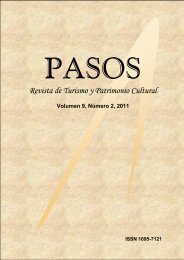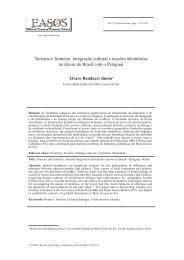Full Journal - Pasos
Full Journal - Pasos
Full Journal - Pasos
You also want an ePaper? Increase the reach of your titles
YUMPU automatically turns print PDFs into web optimized ePapers that Google loves.
96 Repositioning of Barcelona’s Image in the Light of a Redefinition of the Urban Tourism Planning Model<br />
––<br />
The building of an international brand (20.4%)<br />
––<br />
Greater self-respect on the part of the city’s<br />
inhabitants (19.7%)<br />
In addition:<br />
––<br />
Urban policy over the last fifteen years has<br />
been to attract more tourists to Barcelona.<br />
<strong>Full</strong>y 81.9 % of respondents in the sample<br />
agreed with this policy. This figure breaks<br />
down as follows: ‘completely agree’ (23.0%),<br />
‘strongly agree’ (35.5%) ‘agree’ (23.4%)<br />
––<br />
The tourists hordes now flock public spaces to<br />
bursting point (25.3%); have pushed up living<br />
costs in general and housing costs in particular<br />
(13.9%); make a lot of noise (6.4%); have<br />
worsened public spaces, especially those in the<br />
city centre (6.0%); have driven ‘mobbing’ practices<br />
by landlords in certain neighbourhoods<br />
who are eager to evict long-standing residents<br />
so they can cater to tourists or other kinds of<br />
residents (5.6%).<br />
The internal players identified the vectors for<br />
correcting the model by:<br />
––<br />
reducing the overall amount of tourist accommodation<br />
available (18%), and share it out<br />
among new tourist areas (32.9%)<br />
––<br />
studying the carrying capacity of the city’s<br />
most popular tourist areas (85.2%) in order to<br />
manage visitor flows better<br />
––<br />
increasing the amount of public space (24.6%)<br />
to improve residents’ lives and tourists’ experience<br />
of the city<br />
––<br />
decentralising tourism products to take in the<br />
whole of Catalonia (58.6%), and at the metropolitan<br />
level (23.8%)<br />
––<br />
investing in inter-modal transport and links<br />
(45.4%)<br />
Internal players’ vision is thus not one of<br />
serving tourists whatever they want—a feature<br />
of the traditional model—but rather one of creating<br />
an innovative, enriching city that boosts<br />
residents’ quality of life and attracts more discriminating<br />
tourists and visitors.<br />
2.4. External players’ vision<br />
The next step in our study was to establish<br />
a general framework to project expectations of<br />
corrections to Barcelona’s positioning. For this<br />
purpose, we used a Delphi Study with external<br />
players. The fieldwork yielded the following<br />
results:<br />
– International players agreed on various aspects<br />
bearing on the competitiveness of cities:<br />
• The city is viewed as an inter-sectoral activity<br />
(6.2 out of 7) in which tourism is considered:<br />
––<br />
The main activity (5.66 out of 7)<br />
––<br />
The sole economic activity (6.1 out of 7)<br />
––<br />
Just another economic activity (4.90 out<br />
of 7)<br />
––<br />
A less important activity (3.49 out of 7)<br />
• The factors driving city tourism are:<br />
––<br />
The setting: price trends, exchange rates,<br />
the course of the crisis, keeping prices low<br />
––<br />
The quality of attractions: heritage and<br />
cultural attractions, infrastructure, facilities<br />
and services, the ability to forge<br />
alliances with major brands in the metropolitan<br />
and regional setting<br />
––<br />
Lifestyle: gastronomy, fashion, cultural<br />
industries, folklore, social and sporting<br />
events.<br />
––<br />
Maintaining or boosting purchasing power<br />
––<br />
The value of differentiation<br />
––<br />
Maintaining the city brand, especially<br />
through the Internet and social networks<br />
• Leaving the attractiveness of a city’s tourist<br />
products aside, a city’s competitiveness<br />
is strongly linked to various competences<br />
such as: transport connections (6.3 out of<br />
7); direct contact with clients through the<br />
Internet (6.1 out of 7); cultural dynamism<br />
(6.0 out of 7); a tourism tax (5.56 out of 7),<br />
re-investment of revenue from tourism in<br />
maintaining and improving environmental<br />
quality (5.9 out of 7); innovation, interpreted<br />
by the respondents in the sample from<br />
the urban standpoint and as a constant reinvention<br />
of cultural content and lifestyles<br />
(5.8 out of 7).<br />
3. Discussion and proposals<br />
Against a background of wholesale economic<br />
globalisation and despite having smaller<br />
municipal boundaries than its rivals, Barcelona<br />
has risen by leaps and bounds in the rankings<br />
over the last fifteen years and is now comes<br />
after London and Paris. However, the fact that<br />
it occupies third place should not hide the fact<br />
that there is rising competition among cities and<br />
that others covet Barcelona’s hard-won position.<br />
Discussion is based on Barcelona’s successful<br />
tourism model and the need to alter it to strike<br />
a better balance in the use of public space and<br />
thus benefit all the city’s clients. Correcting ‘the<br />
more, the merrier’ model of tourism should take<br />
into account the following reflections:<br />
PASOS. Revista de Turismo y Patrimonio Cultural, 11(1). 2013 ISSN 1695-7121



